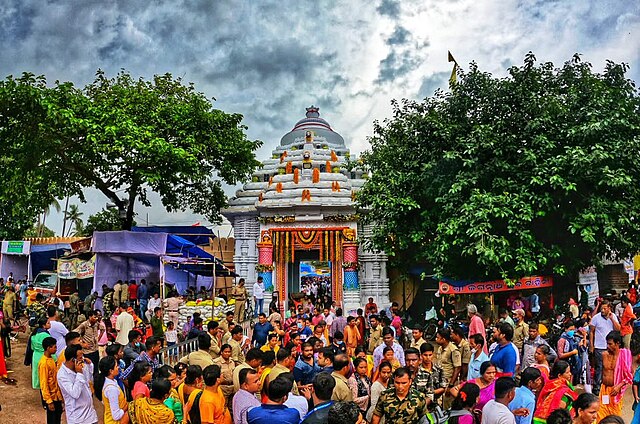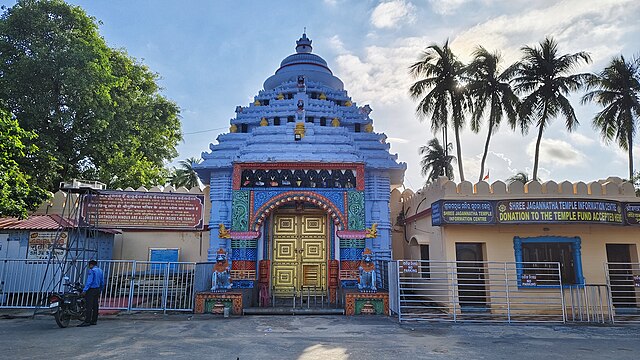Have you ever wondered about the spiritual journey that millions of devotees witness during the famous Rath Yatra festival? At the heart of this divine spectacle lies the Gundicha Temple, a sacred destination that holds profound significance in Hindu mythology and Odishan culture. This isn’t just another temple – it’s the temporary home where Lord Jagannath, along with his siblings, resides for nine blessed days each year.
What is Gundicha Temple?
Gundicha Temple, also known as the “Aunt’s House” or “Gundicha Ghar,” stands as one of the most revered temples in Puri, Odisha. Located approximately 3 kilometers from the famous Jagannath Temple, this sacred structure serves as the destination for the world-renowned Rath Yatra procession. But what makes this temple so special that it draws millions of pilgrims from across the globe?
The temple gets its name from Queen Gundicha, who was believed to be the wife of King Indradyumna, the legendary ruler who established the Jagannath Temple. According to local folklore, she was the aunt of Lord Jagannath, which is why devotees affectionately call this temple the “Mausima Ghara” (Aunt’s House) in Odia.
Historical Significance of Gundicha Temple

Ancient Origins and Legends
The history of Gundicha Temple intertwines beautifully with the ancient legends of Puri. Dating back several centuries, this temple has witnessed countless Rath Yatra festivals and has been the silent guardian of age-old traditions. The structure we see today has undergone various renovations, but its spiritual essence remains unchanged.
Legend tells us that Lord Jagannath expressed his desire to visit his aunt’s house annually, just like any beloved nephew would. This divine wish gave birth to the magnificent Rath Yatra festival, where elaborate chariots carry the deities from their main temple to Gundicha Temple. Isn’t it fascinating how even gods cherish family bonds?
Connection to the Rath Yatra Festival
The temple’s significance skyrockets during the Rath Yatra, one of India’s most spectacular religious festivals. This connection isn’t merely ceremonial – it’s deeply rooted in devotional practices and spiritual beliefs that have been passed down through generations. The temple becomes the focal point of devotion for nine days, transforming into a hub of spiritual energy and divine presence.
Architectural Marvel of Gundicha Temple
Design and Structure
The architectural style of Gundicha Temple reflects the traditional Kalinga architecture that’s characteristic of Odisha’s temple designs. The structure, though simpler than the main Jagannath Temple, carries its own charm and spiritual aura. Built with local stone and following ancient architectural principles, the temple showcases the skilled craftsmanship of Odishan artisans.
The temple complex spans a considerable area, designed to accommodate the massive crowds that gather during the Rath Yatra. The main sanctum, courtyards, and surrounding structures are all planned with both functionality and spiritual significance in mind. Every pillar, every carving tells a story of devotion and artistic excellence.
Sacred Spaces Within the Temple
Inside the temple, you’ll find several sacred spaces, each serving a specific purpose during the deities’ stay. The main sanctum sanctorum, where Lord Jagannath, Balabhadra, and Subhadra reside during their visit, is the most sacred area. The temple also features spacious courtyards where thousands of devotees gather for darshan and participate in various rituals.
The kitchen area, though not as elaborate as the one in the main Jagannath Temple, still follows traditional cooking methods to prepare the sacred food offerings. These spaces come alive during the nine-day festival, buzzing with activity and devotional fervor.
The Spiritual Journey: Rath Yatra and Gundicha Temple
The Nine-Day Stay
The nine-day sojourn at Gundicha Temple, known as “Navami,” represents more than just a religious observance – it’s a spiritual journey that connects devotees with the divine. During this period, the temple transforms into a sacred realm where time seems to stand still, and spiritual energy reaches its peak.
Each day brings its own set of rituals, prayers, and celebrations. The atmosphere during these nine days is electric, with devotees from around the world gathering to witness this divine spectacle. The temple becomes a melting pot of cultures, languages, and traditions, all united by their devotion to Lord Jagannath.
Daily Rituals During the Stay
The daily rituals at Gundicha Temple during the deities’ stay follow a strict schedule that has remained unchanged for centuries. Morning prayers, midday offerings, and evening ceremonies create a rhythm of worship that resonates throughout the temple complex. These rituals aren’t just ceremonial acts – they’re expressions of pure devotion and spiritual connection.
The temple priests, following ancient traditions, perform elaborate ceremonies that include offerings of food, flowers, and prayers. The sound of conch shells, temple bells, and devotional songs creates an atmosphere that’s both mystical and deeply moving.
Devotee Experiences
For devotees, visiting Gundicha Temple during the nine-day festival is often described as a life-changing experience. Many pilgrims travel thousands of miles just to catch a glimpse of Lord Jagannath in his aunt’s house. The sense of peace, devotion, and spiritual fulfillment that visitors experience here is indescribable.
Stories abound of miraculous experiences, answered prayers, and spiritual awakenings that devotees have had at this sacred place. Whether you’re a lifelong devotee or a curious traveler, the temple’s spiritual energy is palpable and transformative.
Cultural Impact and Religious Importance
Role in Odishan Culture
Gundicha Temple isn’t just a religious site – it’s a cultural cornerstone of Odisha. The temple plays a crucial role in preserving and promoting Odishan traditions, art, music, and dance. During the festival period, the temple becomes a stage for classical Odissi dance performances, devotional music concerts, and cultural programs that showcase the rich heritage of the region.
The temple has also been instrumental in maintaining the social fabric of the community. It brings together people from all walks of life, transcending social, economic, and cultural barriers. This unity in diversity is perhaps one of the most beautiful aspects of the Gundicha Temple experience.
Festivals and Celebrations
While the Rath Yatra is the most significant festival associated with Gundicha Temple, the temple also celebrates other important occasions throughout the year. These festivals provide opportunities for the local community to come together, celebrate their shared heritage, and strengthen their spiritual bonds.
The temple’s festival calendar includes various religious observances, cultural events, and community gatherings that keep the spiritual and cultural traditions alive. Each celebration adds to the temple’s rich tapestry of traditions and helps maintain its relevance in contemporary times.
Visiting Gundicha Temple: A Pilgrim’s Guide
Best Time to Visit
While Gundicha Temple welcomes visitors throughout the year, the best time to experience its full glory is during the Rath Yatra festival, which typically falls in June or July. However, if you prefer a more peaceful and contemplative visit, the months of October to March offer pleasant weather and fewer crowds.
During the festival season, be prepared for massive crowds and plan your visit accordingly. The experience, though overwhelming at times, is spiritually rewarding and unforgettable. For those seeking a quieter spiritual experience, visiting during off-peak months allows for more personal reflection and peaceful darshan.
How to Reach Gundicha Temple

Reaching Gundicha Temple is relatively straightforward, thanks to Puri’s well-connected transportation network. The temple is easily accessible by road from the main Jagannath Temple, and during the Rath Yatra, special arrangements are made for pilgrims to travel between the two temples.
Local transportation options include auto-rickshaws, cycle-rickshaws, and walking, which is often the preferred method during festival times. The journey itself becomes part of the spiritual experience, especially when undertaken with fellow devotees sharing the same divine purpose.
Preservation and Modern Challenges
Like many ancient temples, Gundicha Temple faces challenges related to preservation, crowd management, and maintaining its spiritual sanctity in an increasingly commercial world. The temple authorities, along with government agencies and devotee organizations, are working tirelessly to address these challenges while preserving the temple’s authentic character.
Modern infrastructure improvements, crowd control measures, and conservation efforts are being implemented to ensure that future generations can continue to experience the temple’s spiritual magnificence. The balance between preservation and accessibility remains a delicate one, requiring constant attention and care.
Conclusion
Gundicha Temple stands as a testament to the enduring power of faith, tradition, and cultural heritage. More than just a destination for the Rath Yatra, it represents the beautiful relationship between the divine and devotees, between tradition and modernity, and between individual spirituality and collective celebration.
Whether you’re drawn by religious devotion, cultural curiosity, or spiritual seeking, Gundicha Temple offers an experience that touches the soul and enriches the spirit. It reminds us that in our fast-paced world, there are still places where time-honored traditions thrive, where community bonds strengthen, and where the divine presence can be felt in every prayer, every ritual, and every moment of devotion.
The temple’s message is simple yet profound: in the house of the divine, all are welcome, all are family, and all are blessed. As Lord Jagannath returns to his aunt’s house each year, he brings with him the promise of renewal, hope, and unconditional love that continues to inspire millions of hearts worldwide.
Frequently Asked Questions
Q1: What is the significance of the name “Gundicha Temple”?
A: Gundicha Temple is named after Queen Gundicha, the wife of King Indradyumna who established the Jagannath Temple. She is considered the aunt of Lord Jagannath, which is why the temple is affectionately called “Mausima Ghara” or “Aunt’s House” in the local Odia language.
Q2: How long do the deities stay at Gundicha Temple during Rath Yatra?
A: The deities – Lord Jagannath, Balabhadra, and Subhadra – stay at Gundicha Temple for nine days during the Rath Yatra festival. This period is known as “Navami” and is considered highly auspicious by devotees.
Q3: Can visitors enter Gundicha Temple throughout the year?
A: Yes, Gundicha Temple is open to visitors throughout the year, though the most significant time to visit is during the Rath Yatra festival when the deities are present. During other times, the temple serves as a place for prayer and meditation for local devotees and tourists.
Q4: What is the distance between Jagannath Temple and Gundicha Temple?
A: Gundicha Temple is located approximately 3 kilometers from the main Jagannath Temple in Puri. The route between the two temples is the path taken by the grand chariots during the Rath Yatra procession.
Q5: Are there any specific rituals that visitors should be aware of when visiting Gundicha Temple?
A: Visitors should follow general temple etiquette such as removing shoes before entering, dressing modestly, and maintaining silence in sacred areas. During the Rath Yatra period, specific darshan timings are observed, and visitors should be prepared for large crowds and longer waiting times. Photography may be restricted in certain areas of the temple.

